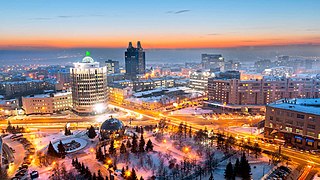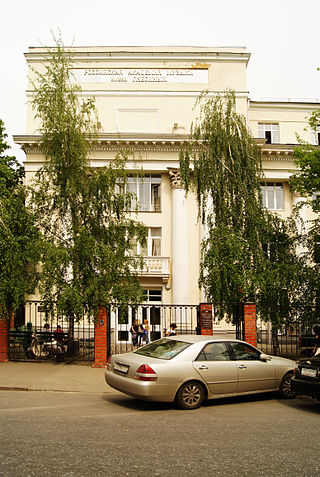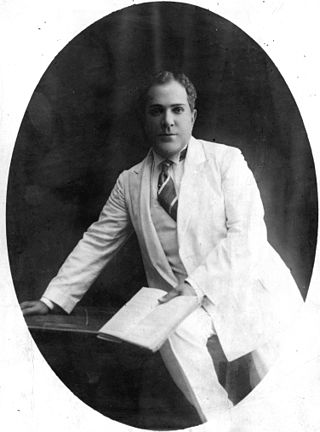
Novosibirsk is the largest city and administrative centre of Novosibirsk Oblast and the Siberian Federal District in Russia. As of the 2021 Census, it had a population of 1,633,595, making it the most populous city in Siberia and the third-most populous city in Russia after Moscow and Saint Petersburg. The city is located in southwestern Siberia, on the banks of the Ob River.

Mikhail Ivanovich Glinka was the first Russian composer to gain wide recognition within his own country and is often regarded as the fountainhead of Russian classical music. His compositions were an important influence on other Russian composers, notably the members of The Five, who produced a distinctive Russian style of music.

The N. A. Rimsky-Korsakov Saint Petersburg State Conservatory is a school of music in Saint Petersburg, Russia. In 2004, the conservatory had around 275 faculty members and 1,400 students.

The Moscow Conservatory, also officially Moscow State Tchaikovsky Conservatory is a musical educational institution located in Moscow, Russia. It grants undergraduate and graduate degrees in musical performance and musical research. The conservatory offers various degrees including Bachelor of Music Performance, Master of Music and PhD in research.

The Gnessin State Musical College and Gnesins Russian Academy of Music is a music school in Moscow, Russia.

FC Sibir Novosibirsk was a Russian association football club based in Novosibirsk, playing at the Spartak Stadium. They played their first-ever season in the Russian Premier League in 2010, and ended with relegation to the Russian First Division.
Vladimir Nikolaïevitch Chernov is a Russian baritone, particularly associated with the Russian and Italian opera repertories.

Pyotr Ivanovich Slovtsov was a famous Russian tenor.
Abram Leontievich Markson was a Russian and Soviet violinist and conductor. He was of Jewish origin.
Vladimir Andreyevich Atlantov, is a Soviet and Russian operatic tenor.

Dmitri Tcherniakov is a Russian theatre director, and winner of numerous national Golden Mask theatre awards, who works with many European opera houses.
Erzhan Kulibaev is a Spanish violinist of Kazakh origin.
The following is a timeline of the history of the city of Novosibirsk, Russia.

Zheleznodorozhny District is an administrative district (raion) of Central Okrug, one of the 10 raions of Novosibirsk, Russia. The area of the district is 8.3 sq km. Population: 64 972 (2017).

Kirovsky District is an administrative district (raion), one of the 10 raions of Novosibirsk, Russia. It is located on the left bank of the Ob River. The area of the district is 50,7 km2. Population: 186,408.

Pervomaysky District is an administrative district (raion), one of the 10 raions of Novosibirsk, Russia. The area of the district is 68.28 square kilometres (26.36 sq mi). Population: 87,912.

Michurin Street is a street in Tsentralny City District of Novosibirsk, Russia. It runs south-north. The street starts from Ordzhonikidze Street opposite the Novosibirsk Opera and Ballet Theatre, crosses Yadrintsevskaya, Frunze, Krylov, Gogol streets and then forms a T-intersection with Pisarev Street.
Nadezhda Alexandrovna Deziderieva-Buda was a Russian mezzo-soprano at the Novosibirsk Opera and Ballet Theatre (1944–1964), director of the music school in Novosibirsk and cultural figure.
Yevgeny Pavlovich Gorbenko was a Soviet choirmaster, music teacher, the first chief choirmaster of the Novosibirsk Opera and Ballet Theatre, Honored Artist of the RSFSR (1955).
Olga Vasilievna Titkova is the leading soloist of the Novosibirsk Musical Theatre, Merited Artist of the RSFSR (1988), People's Artist of Russia (2004), winner of the Golden Mask theatre award (2002).
This page is based on this
Wikipedia article Text is available under the
CC BY-SA 4.0 license; additional terms may apply.
Images, videos and audio are available under their respective licenses.












